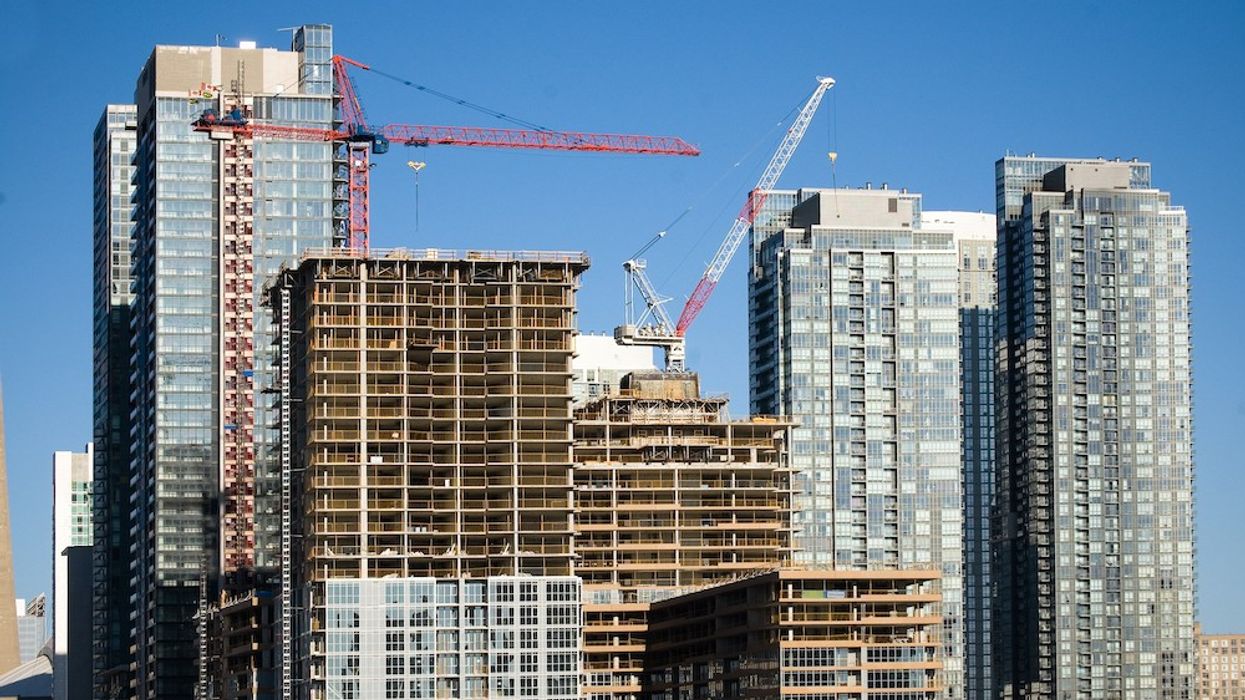It isn’t easy to get developers to chat on the record about the good, bad, and ugly of doing business in today’s challenging economy.
Earlier this week, however, some of Toronto’s most influential developers got candid at Dive in with Developers, a fundraising event hosted by RARE Real Estate Inc. Held at the Aga Khan Museum, the event united the who’s who of the city’s pre-construction industry for an insightful panel discussion that raised important funds -- a record-breaking $205,000 -- for SickKids’ epilepsy classroom. The classroom is designed to meet the needs of children with active epilepsy and those who have gone through brain surgery for epilepsy.
Moderated by Ryan Rabinovich (Founder, RARE Real Estate), the panel featured Brian Brown (Principal, LifeTime Developments), Kalliopi Karkas (Vice President, RioCan Living), Matt Young (President and CEO, Republic Developments), Bryan Levi (CEO DBS Developments), and Kash Pashootan (Founder and CEO, EMBLEM Developments). It offered an engaging and honest conversation about what it’s really like to be a developer in an economy riddled with climbing interest rates, supply chain pressures, heightened construction costs, and labour shortages.
Things are Going to be Slow for the Next Little While... But We're Not in a Bubble
There was no sugar-coating it: the panelists agreed that the real estate industry is going to be slow for the next little while. In this climate, both buyers and developers are sitting on the sidelines, with everyone trying to time the dramatic market.
“Across the board, there’s going to be a bit of a slowdown; there’s going to be fewer people looking to get into the market and purchase and there’s going to be fewer developers that want to launch, because they’re wondering how low it will go and when they can increase prices,” says Karkas. “It’s going to be a bit of a dance that both sides will play for at least the next 12 months. The projects that are coming to market have been thought through. They’re coming to market because a developer believes in a project, believes in a location, believes they’ve got something unique, and are preparing to have a slower go at it. We need to work harder to communicate the messaging to potential investor buyers about why it’s a good opportunity and that we’re not in a bubble.”
Despite perpetual headlines that suggest otherwise, the panelists agree with her; while we are in a challenging economy and a softening real estate market, we’re not in a bubble.
“Right now, we are expecting things to be a little slower,” says Levi. “But if you go back three, five, maybe 10 years, the market has always changed, and the way we sell it has always changed. Over the past five years, it seems we’ve moved away from really taking time to sell or focus on the process of selling. We’ve moved away from the sales office. I think we need to relook at where we are and adjust, and the program could look a little different. At the same time, people who are buying today aren’t buying based on today’s interest rates. They’re putting money down today, but they won’t take occupancy for four years. So, it’s about thinking about where we’ll be then.”

Immigration is Great for Business, But We Need Short-Term Strategies
A resonating sentiment among panelists was that mass immigration will be good for business when it comes to offsetting current challenges in the market.
“Positive economic factors include our immigration policy,” says Karkas. “It’s a good news story from a development point of view. I think it’s doing all the right things. We have a bunch of things that could be called sore spots: construction cost increases, labour shortages, high interest rates, and it’s more expensive to build and carry a project. Immigration is one of the positive things happening for residential real estate, however, especially when people continue to move into the city at exponential rates.”
Karkas points to the perpetual construction in the GTA and its ramifications for developers. “There are a ton of cranes in the sky, which means that a ton of people are building,” she says. “This means that everyone is competing for the same people to sell their projects and build their projects. The labour shortage will have a negative impact, but at the end of the day, the supply and demand will keep us moving forward in a positive direction and offset some of these challenges.”
In addition to filling towering new GTA condo developments with buyers, immigration will bring desperately needed skilled labour to help get projects built sooner. Rabinovich points to recent reports show there are 1M unfilled positions in Canada -- 10% of them in the skilled trades.
“Immigration brings in skilled trades from other countries that may not have the same political and economic stability as Canada; those people would much rather be here,” says Young. “We can use that to solve some of our structural challenges to our economy. You can’t take 18-year-olds and turn them into skilled trade labourers overnight. It’s going to take many years; and when that’s happening, we’re going to continue to under supply the housing market, prices are going to continue to go up, and you’re going to push people out. Immigration can help solve some of those problems.”
The reality is, however, that immigration won’t fix things overnight either. “If we’re being frank, we all know the immigration story; we all know that it’s positive and is a catalyst,” says Pashootan. “But -- ask any real estate professional in this room, or any buyer -- nobody cares right now. We all know the immigration story, but it still doesn’t feel very good. From a strategy perspective, it’s important to focus on the short-term to then be able capitalize on the long-term -- the fact that we have immigration. We’ve had lots of great immigrants come to the country this year, but pre-con is slow. We’re going to have a lot of great immigrants come next year and pre-con will continue to be slow.”
Pashootan says it’s important not to substitute the fact that there’s going to be immigration with the fact that we will still face a challenging environment. “So, what do we do in a challenging environment? Part of it involves adjusting expectations for all of us in this room -- from both a developer perspective and a pre-con perspective,” says Pashootan. “And we eventually need to translate that to the buyers, so that they too can adjust their expectations. Until we do that, we’re going to have this gridlock between the great things of the long-term and the challenges of the short-term. I don’t think any of us are going to get anywhere for at least 12 months, but I think it’s going to be challenging if we’re thinking just about the long-term.”
Sales Prices Won't Drop -- Because Projects Won't be Feasible Otherwise
In today’s climate, it’s incredibly expensive to bring projects to market. So, potential buyers hoping for significant price drops in the pre-con market won’t see them, say the developers. The plain and simple reason is that shiny, new condos won’t get built otherwise. So, while we may see periods of softening in the market, prices won’t drop significantly.
“I don’t think there’s a scenario where sales prices are going to come down,” says Levi. “If anything, we’re looking at these projects that are coming down the pipeline and quite honestly expecting prices to continue to rise. At the end of the day, costs are going up; they’ve gone up well over 30%. And the costs coming in are escalating so rapidly that the sales prices need to be higher to make those projects feasible and get them built. So, I don’t see a scenario where buyers can time the market and sit on the sidelines and see a dramatic price drop -- I don’t see that happening.”
There’s not much that developers can do about it; rising costs are out of their control, they say. “We need large banks to finance these projects,” says Young. “There’s only so much we can do. We can maybe find better deals on land, but then landowners won’t sell it; they’ll keep it for the next 20 years. At least in the condo space, costs are what drive the market. For a project I purchased last year, we are re-running our numbers this year and, to net even, pricing has to go up $65-$70 psf -- just to net even. That’s one year and we’ve now gone through six to eight months of what’s been a tough market, with construction costs and development charges going up. So, we may see a little bit of softening, but won’t see discounts.”
While costs will come down eventually, it won’t happen overnight, says Pashootan. And they won’t drop to the point that they’ll significantly impact prices.
“If buyers are waiting for the day when condos are going to come to market for $100 to $200 less a foot, it’s not going to happen,” says Pashootan. “The reason is very straight forward: nobody is going to build a project that’s going to lose money. Costs will come down if this market is slow for a long period of time, but that won’t happen tomorrow. In order for costs to come down -- and, eventually, for the price of condos to come down -- we’re talking three or four years out. We don’t see a scenario where prices are going to come down to the point where we can justify selling condos at lower prices. So, developers will cancel projects, they’ll hold off before launching. This isn’t a market where prices will drop.”
Pashootan says EMBLEM Developments hasn’t changed their system despite the current climate. “We’re buyers,” he says. “We’re not making decisions based on what’s going on today. Certainly, we’re being a little more cautious, and making sure we have ample liquidity. I think from a developer’s perspective, the environment we are in translates to challenges, like lenders may require more liquidity to feel safer. Liquidity is key in this environment. We have a big machine, we need to keep it going. We can’t wait two years, then buy land. We need to be at certain stages of development all the way through at all times. We haven’t changed our underwriting system.”
Pashootan says EMBLEM is fairly conservative and doesn’t like to bet too much as to what it going to happen in the future. “That’s why we like suburb markets; because of the affordability for buyers and the price that you can buy land at. If you bought land at the top of the market in Yorkville last year, you have a problem right now. If you can sit on it and wait long enough, that’s ok. But we don’t like to be in that position. We like to get in and get out and keep the machine going. So, we’ve always carried a percent contingency, we’ve always been involved with our trades, and we haven’t taken density risks.”
Challenges constantly arise between acquisition, through construction, and occupancy that can cause costly delays. “The killer of any project is delays of any type,” says Karkas. “Every month delayed in the approval process adds $3 per square foot. If I acquired a site, every month it takes me, the land loan on that project is just ticking away at my IRR with every month passes. On the construction side, if my design drawings aren’t 100%, I can’t start construction -- I can’t tender my trades. Every month that goes by, if I can’t tender my trades, I’m dealing with construction cost escalation. Once I’m building, if I’m delayed, I have delayed occupancy claims and unhappy purchasers.”
When it comes to time, RioCan is in a unique situation because it builds on existing retail sites, rather than acquiring them. This gives them more time. “Sometimes it feels like we have all the time in the world,” says Karkas. It's a luxury most developers don’t have. “We have time to make sure we do geo testing, our design drawings are all 100%, we’ve had projects where we’ve secured trades before we’ve even gone to sales," she says. "This helps combat some of the ambiguity that inevitably leads to those delays.”
Rabinovich highlights how fees can be anywhere from 23-50% of the total sticker price of the project. In fact, Toronto has the highest development fees in the country.
Brown explains how the model for development has changed to account for higher costs. “It used to be that you’d try to get through zoning first, then get through sales, then once we hit that 70-75% target and knew we have construction financing, it would only take a year to do our construction costs," he says. "That’s changed. Now, we get our zoning, we do our construction drawings, then go to sales. The reason why is that we want to have control of our costs. The waiting period between sales and construction, if costs go up too much, we sold for not enough of our costs. I do believe Doug's Ford's announcement will bring good news and people can agree costs are getting out of control.”

Developers Need More Support. Now.
At Monday’s event, Ontario premier Doug Ford had yet to introduce his sweeping new housing legislation, but panelists referenced rumours of it -- and were all for it. The new legislation, if passed, would override municipal zoning to allow multiple units as of right on all residential lots, cut development fees, and bar residents or environmental groups from appealing a development to the Ontario Land Tribunal (OLT) -- all major wins for developers. At the same time, the legislation would limit affordable housing requirements, constrict the oversight of conservation authorities when developing conservation land, and reduce public consultation for new developments.
The panelists collectively called for the elimination of red tape that slows down the construction of desperately-needed new homes.
“From the point of acquisition to the point you actually start construction, your performance can change quite a bit,” says Brown. “Developing relationships with the City of Toronto has been a challenge over the years. And, unfortunately, what should be a more partnership approach from the City doesn’t really exist. We’re often seen by the community as someone that’s coming in and making massive changes to the neighbourhood and people are scared by the notion of change. There’s these challenges that mean that we have to spend a lot of time with the community and talking to our agents to about the sites and what’s attractive to them and where we can achieve the greatest outcome. It requires a lot of soul searching to be able to have those conversations with people outside of your core industry.”
As Rabinovich points out, it takes just one person with a $400 appeal to delay a multi-million dollar project for at least a year. “We have a regime that prioritizes that appeal,” says Karkas.
But the city has to grow around infrastructure like public transit. There’s no way around it. “It’s not that we don’t value what individual homeowners have to say,” Pashootan says. “But we have a housing crisis and we need to think about how we remedy and improve this. And not everyone is going to like it. If our priority is to address housing, we will have to upset a small group of people to benefit a much larger group of people. From a political perspective, we are concerned about the optics about how the small group will be affected, we’ll never be able to help the larger group.”
Young says that every developer is feeling the pressure on their projects when it comes to relentlessly navigating red tape and delays.
“Time is so important,” says Young. “One thing we really try to do is advocate to the City that every month they delay us, we need more in order to make this feasible -- every month they drag their feet, we need to push a little more. So, if they want to work with us, the best thing they can try to do is be collaborative and get to the key issues immediately to move things forward. The City has become more of a challenge to work with in recent years. It’s almost like they purposely attempted to reject some of the policies put forth by the provincial government, and it’s made it difficult. So, I do think the announcement tomorrow will have a lot of positive ramifications on the industry.”
Naturally, he wasn't alone in this sentiment. “At the end of the day, developers need their required yield on a project, between your land costs, hard costs, soft costs, financing costs,” says Levi. “There’s not much you can do from an underwriting perspective other than adding contingencies. You can have a good understanding of your costs and revenue figures, but there’s a lot of unknowns in terms of policy as well... If your required term is fixed for the bank and other stakeholders and your costs are escalating over 30%, what are you going to do? At the end of the day, you’ve got to push forward. We’re just optimistic that the pricing is where it needs to be to get the projects built."





















